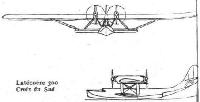
Описание
Страна : Франция
Год : 1931
Летающая лодка
Дальняя патрульная летающая лодка
Latecoere 300, 301 и 302
Latecoere 300.01 был первой четырехмоторной летающей лодкой компании, первый полет самолет выполнил 17 декабря 1931 года, но он же стал и последним - самолет упал в воду и разрушился.
Трехмоторный прототип Latecoere 50 совершил свой первый полет через три месяца, но его характеристики оказались очень плохими. Компания решила прекратить его разработку и вернуться к варианту четырехмоторного самолета, в котором двигатели располагались тандемно. Задачей разработчиков было создание самолета, который позволил бы надежно связать по воздуху Дакар (Сенегал) и Натал (Бразилия), причем машина должна была перевозить значительное количество почты.
Первый Latecoere 300 был восстановлен и вновь поднялся в воздух в сентябре 1932 года. Самолет получил название "Croix-du-Sud" ("Южный Крест") и вскоре совершил беспосадочный перелет из французского Берре в Сенегал (Западная Африка), установив рекорд дальности, а затем перелетел в бразильский Натал, достигнув его 2 января 1933 года. Вскоре после этого самолет был модифицирован и совершил несколько трансатлантических перелетов, однако 7 декабря 1936 года он пропал над океаном - вместе со своим экипажем, включая знаменитого Жана Мермоза.
В 1935 году были построены три Latecoere 301, они в целом были схожи с моделью Latecoere 300. Все они были почтовыми самолетами, имели экипаж из четырех человек и оснащались четырьмя двигателями Hispano-Suiza мощностью по 650 л. с., установленными тандемно на крыле. Самолеты получили имена в честь столиц южноамериканских государств и использовались на южно-атлантических маршрутах компании "Air France". Один самолет был потерян в море в феврале 1936 года, второй списали после активной эксплуатации. Третья машина в феврале 1938 года была передана авиации ВМС Франции, с началом войны ее передали в эскадрилью E.4, дислоцированную в Дакаре, для выполнения противолодочного патрулирования.
Три самолета Latecoere 302 в 1936 году передали эскадрилье E.4, дислоцированной в Берре. Самолеты имели экипаж из восьми человек и получили имена "Guilbaud", "Mouneyres" и "Cavelier de Cuverville". Машины использовались для дальнего патрулирования, в составе 41-й эскадрильи (бывшая E.4) они были передислоцированы в Дакар, где и эксплуатировались вплоть до своего списания в 1941 году.
ТАКТИКО-ТЕХНИЧЕСКИЕ ХАРАКТЕРИСТИКИ
Latecoere 302
Тип: дальняя патрульная летающая лодка
Силовая установка: четыре V-образных 12-цилиндровых двигателя с жидкостным охлаждением Hispano-Suiza 12Ydrs мощностью по 860 л. с. (641 кВт)
Летные характеристики: максимальная скорость 215 км/ч; практический потолок 5800 м; максимальная дальность 3250 км
Масса: пустого снаряженного 13 230 кг; максимальная взлетная 24000 кг
Размеры: размах крыла 44,00 м; длина 26,15 м; высота 7,98 м; площадь крыла 255,66 м2
Вооружение: один 7,5-мм пулемет Dame в носовой кабине и два таких же пулемета в бортовых установках, плюс четыре 75-кг авиабомбы на держателях, установленных на подкосах крыла
Описание:
- Latecoere 300, 301 и 302
- Flight, January 1932
The Latecoere Lat. 300
Фотографии
-
Aeroplane Monthly 1990-03 / J.Stroud - Wings of Peace
Регистрационный номер: F-AKGF [4] The Latecoere 300 Croix du Sud before the vertical tail surfaces were heightened and the wing given marked dihedral.
-
Мировая Авиация 168
Регистрационный номер: F-AKGF [4] "Croix-du-Sud" стал единственным представителем модели Latecoere 300. Самолет был восстановлен после крушения и получил новую регистрацию F-AKGF.
-
Flight 1932-01 / Flight
Регистрационный номер: F-AKCU [2] THE LATECOERE 300: The photograph shows the machine at moorings: Note that the pusher airscrews are three-bladed, while the tractors are two-bladed.
-
Aeroplane Monthly 1990-03 / J.Stroud - Wings of Peace
This view of the Latecoere 300 shows how the sponson layout was continued even in the bigger flying-boats.
-
Flight 1932-01 / Flight
Регистрационный номер: F-AKCU [2] THE LATECOERE 300: The photograph, showing the launching, gives a good idea of the size of the machine.
-
Flight 1934-02 / Flight
ON THE SOUTH ATLANTIC SERVICE: The Latecoere 300 flying boat. It was on this type of machine, the Croix du Sud, that Capt. Bonnot made the double crossing recently.
-
Jane's All the World Aircraft 1980 / Encyclopedia of Aviation - Aircraft A-Z - v4
Регистрационный номер: F-AKGF [4] Latecoere 300.
-
Jane's All the World Aircraft 1938 / 01 - The progress of the world in civil aviation during the year 1937-38
Регистрационный номер: F-AOIL TRANSATLANTIC TERMINUS. - A Four-motored Latecoere Flying-boat of Air-France, as used on the South Atlantic service, being refuelled at Dakar from 50-gallon drums. Landplanes are used North of here.
-
Aeroplane Monthly 1990-03 / J.Stroud - Wings of Peace
Регистрационный номер: F-AOIK The Latecoere 301 Ville de Buenos Aires.
-
Мировая Авиация 168
Это самолет "Mouneyres" - один из трех Latecoere 302, военной версии почтового Latecoere 301. Машины предназначались для дальнего морского патрулирования.
-
Aeroplane Monthly 1990-03 / J.Stroud - Wings of Peace
Регистрационный номер: F-AKGF [4] KEITH WOODCOCK'S painting shows the Latecoere 300 Croix du Sud.
-
Flight 1937-10 / Flight
Latecoere 300 Croix du Sud.
-
Flight 1932-01 / Flight
LAT.300 4 Hispano-Suiza Engines, 650 h.p. each
- Фотографии













